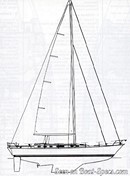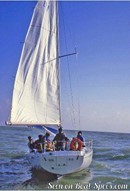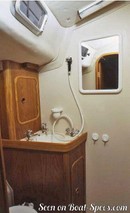Idylle 15.50
Sailboat specifications
The Idylle 15.50 is a 49’11” (15.22m) cruising sailboat designed by Frers Naval Architecture & Engineering (Argentina). She was built between 1985 and 1988 by Bénéteau (France).
Idylle 15.50's main features
- Model
- Idylle 15.50
- Hull type
- Monohull
- Category
- Offshore cruising sailboat
- Sailboat builder
- Sailboat designer
- Sailboat range
- Country
- France
- Construction
- GRP (glass reinforced polyester):
- Hull: Single skin fiberglass polyester
- Deck: Sandwich balsa fiberglass polyester - First built hull
- 1985
- Last built hull
- 1988
- Appendages
- Keel : fin without bulb
- Helm
- Single helm wheel
- Rudder
- Single spade rudder
- Unsinkable
- No
- Trailerable
- No
- Former French navigation category
- 1
- Standard public price ex. VAT (indicative only)
- N/A €
Idylle 15.50's main dimensions
- Overall length
- 51’ 5”15.68 m
- Hull length
- 49’ 11”15.22 m
- Waterline length
- 37’ 11”11.56 m
- Beam (width)
- 14’ 8”4.47 m
- Draft
- 6’1.83 m
- Light displacement (MLC)
- 33069 lb15000 kg
- Ballast weight
- 13007 lb5900 kg
Idylle 15.50's rig and sails
- Upwind sail area
- 1410 ft²131 m²
- Mainsail area
- 474 ft²44 m²
- Genoa area
- 936 ft²87 m²
- Staysail area
- 258 ft²24 m²
- Stormjib area
- 161 ft²15 m²
- Rigging type
- Cutter Marconi masthead
- Mast configuration
- Keel stepped mast
- Rotating spars
- No
- Number of levels of spreaders
- 2
- Spreaders angle
- 0 °
- Spars construction
- Aluminum spars
- Standing rigging
- 1x19 strand wire
Idylle 15.50's performances
- Upwind sail area to displacementiThe ratio sail area to displacement is obtained by dividing the sail area by the boat's displaced volume to the power two-thirds.
The ratio sail area to displacement can be used to compare the relative sail plan of different sailboats no matter what their size.
Upwind: under 18 the ratio indicates a cruise oriented sailboat with limited performances especially in light wind, while over 25 it indicates a fast sailboat. - 232 ft²/T21.54 m²/T
- Displacement-length ratio (DLR)iThe Displacement Length Ratio (DLR) is a figure that points out the boat's weight compared to its waterline length. The DLR is obtained by dividing the boat's displacement in tons by the cube of one one-hundredth of the waterline length (in feet).
The DLR can be used to compare the relative mass of different sailboats no matter what their length:
a DLR less than 180 is indicative of a really light sailboat (race boat made for planning), while a DLR greater than 300 is indicative of a heavy cruising sailboat. - 275
- Ballast ratioiThe Ballast ratio is an indicator of stability; it is obtained by dividing the boat's displacement by the mass of the ballast. Since the stability depends also of the hull shapes and the position of the center of gravity, only the boats with similar ballast arrangements and hull shapes should be compared.
The higher the ballast ratio is, the greater is the stability. - 39 %
- Critical hull speediAs a ship moves in the water, it creates standing waves that oppose its movement. This effect increases dramatically the resistance when the boat reaches a speed-length ratio (speed-length ratio is the ratio between the speed in knots and the square root of the waterline length in feet) of about 1.2 (corresponding to a Froude Number of 0.35) . This very sharp rise in resistance, between speed-length ratio of 1.2 to 1.5, is insurmountable for heavy sailboats and so becomes an apparent barrier. This leads to the concept of "hull speed".
The hull speed is obtained by multiplying the square root of the waterline length (in feet) by 1.34. - 8.25 knots
Idylle 15.50's auxiliary engine
- Engine(s)
- 1 inboard engine
- Engine(s) power
- 85 HP
- Fuel type
- Diesel
- Fuel tank capacity
- 132.1 gal500 liters
Idylle 15.50's accommodations and layout
- Cockpit
- Closed aft cockpit
- Cabin(s) (min./max.)
- 3 / 4
- Berth(s) (min./max.)
- 6 / 12
- Head(s)
- 3
- Freshwater tank capacity
- 237.8 gal900 liters
- Boiler capacity
- 11.1 gal42 liters
- Maximum headroom
- 6’ 11”2.1 m
Idylle 15.50's saloon
- Maximum headroom
- 6’ 7”2 m
Idylle 15.50's fore cabin
- Berth length
- 6’ 7”2 m
- Berth width
- 4’ 7”1.4 m



Bénéteau Idylle 15.50 sailplan - - 2/10
Picture extracted from the commercial documentation © Bénéteau
Picture extracted from the commercial documentation © Bénéteau




Bénéteau Idylle 15.50 sailing - - 5/10
Picture extracted from the commercial documentation © Bénéteau
Picture extracted from the commercial documentation © Bénéteau


Bénéteau Idylle 15.50 sailing - - 6/10
Picture extracted from the commercial documentation © Bénéteau
Picture extracted from the commercial documentation © Bénéteau


Bénéteau Idylle 15.50 interior and accommodations - - 7/10
Picture extracted from the commercial documentation © Bénéteau
Picture extracted from the commercial documentation © Bénéteau


Bénéteau Idylle 15.50 interior and accommodations - - 8/10
Picture extracted from the commercial documentation © Bénéteau
Picture extracted from the commercial documentation © Bénéteau


Bénéteau Idylle 15.50 interior and accommodations - - 9/10
Picture extracted from the commercial documentation © Bénéteau
Picture extracted from the commercial documentation © Bénéteau


Bénéteau Idylle 15.50 interior and accommodations - - 10/10
Picture extracted from the commercial documentation © Bénéteau
Picture extracted from the commercial documentation © Bénéteau
Similar sailboats that may interest you:
Sailboats
First built hull
Hull length
1978
45’ 4”13.8 m
1982
45’ 10”13.95 m
2004
49’ 2”14.99 m
2014
49’ 2”14.99 m
1997
50’ 7”15.42 m
1988
52’ 6”16 m
2012
54’ 8”16.68 m
1995
48’ 6”14.78 m
1987
51’ 10”15.78 m
1987
48’ 1”14.65 m
1986
56’ 4”17.15 m
2000
52’ 6”16 m
2017
50’ 11”15.51 m
1984
42’ 4”12.9 m
1992
48’ 10”14.88 m